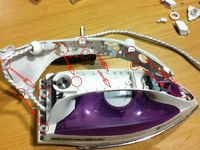Steam Irons: Difference between revisions
No edit summary |
(Added specific fault info.) |
||
| Line 12: | Line 12: | ||
On reassembly, ensure that any tubes associated with the water reservoir and steam delivery are properly connected. | On reassembly, ensure that any tubes associated with the water reservoir and steam delivery are properly connected. | ||
== Specific Faults == | |||
=== Worn Flex === | |||
Because the iron gets moved around a lot, the mains flex gets flexed a lot causing one or more of the conductors to break, usually close to the iron body. | |||
This can be diagnosed with a multimeter or, more easily, a non-contact voltage detector. | |||
Either cut the current flex back to before the break then reconnect it or replace it with a compatible heat-resistant flex. | |||
=== Thermostat === | |||
The thermostat switches the element off when the iron gets up to temperature and back on when it cools down a bit. | |||
Usually it is a pair of contacts, one of which is a bimetallic strip which bends away from the other contact when it heats up. | |||
The distance between the contacts is adjusted by a threaded shaft attached to the temperature control knob. | |||
If the electrical continuity is otherwise good and the element shows the correct resistance, but the iron won't heat up, try cleaning the thermostat contacts and checking that they actually connect | |||
=== No Steam === | |||
If the iron is heating up but isn't producing steam, this is almost certainly a mechanical problem, usually caused by limescale: descale it. | |||
[[Category:General]] | [[Category:General]] | ||
Revision as of 13:31, 3 November 2018
This page covers steam irons.
Summary
Steam irons are quite often seen at Restart parties. They can be challenging to open, and as with any appliance which mixes water and electricity the fault can often be due to a failure, ultimately, to keep them sufficiently apart.
Disassembly
Usually there will be one or two easily accessible screws at the back of the handle but these may only release that part of the handle. Another screw or screws near the front may be hidden for example under the steam button, but even after removing these the handle cover can be tricky to remove. Often there will be a series of clips down the sides, but this may not be all. In the iron illustrated there was another clip to be released on the top just forward of the cable which required the whole of the top cover to be pushed forward.
With the top cover off it should be possible to find the screws which release the whole of the plastic top, in order to access the thermostat etc. and (if not already accessible) to replace the mains lead.
On reassembly, ensure that any tubes associated with the water reservoir and steam delivery are properly connected.
Specific Faults
Worn Flex
Because the iron gets moved around a lot, the mains flex gets flexed a lot causing one or more of the conductors to break, usually close to the iron body. This can be diagnosed with a multimeter or, more easily, a non-contact voltage detector. Either cut the current flex back to before the break then reconnect it or replace it with a compatible heat-resistant flex.
Thermostat
The thermostat switches the element off when the iron gets up to temperature and back on when it cools down a bit. Usually it is a pair of contacts, one of which is a bimetallic strip which bends away from the other contact when it heats up. The distance between the contacts is adjusted by a threaded shaft attached to the temperature control knob.
If the electrical continuity is otherwise good and the element shows the correct resistance, but the iron won't heat up, try cleaning the thermostat contacts and checking that they actually connect
No Steam
If the iron is heating up but isn't producing steam, this is almost certainly a mechanical problem, usually caused by limescale: descale it.
